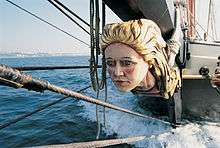Figurehead
In politics, a figurehead is a person who de jure (in name or by law) appears to hold an important and often supremely powerful title or office, yet de facto (in reality) exercises little to no actual power. This usually means that they are head of state, but not head of government. The metaphor derives from the carved figurehead at the prow of a sailing ship.

Examples
Monarchs in some constitutional monarchies, and presidents in semi-presidential republics are often considered to be figureheads. Commonly cited figureheads include Elizabeth II,[1][2] who is queen of 16 Commonwealth realms and head of the Commonwealth, but has no power over the nations in which she is not head of state and does not exercise power in her own realms on her own initiative. Other figureheads include the emperor of Japan and the king of Sweden, as well as presidents in a majority of parliamentary republics, such as the president of India, Israel, Bangladesh, India, Greece, Hungary, Germany, and Pakistan.
During the crisis of the March on Rome in 1922, King Victor Emmanuel III of Italy, though a figurehead, played a key role in handing power to Benito Mussolini. More than 20 years later, the same King played a key role in the dismissal of Mussolini in 1943. Since the abolition of the monarchy in Italy and the establishment of a republic in 1946, the president of Italy assumed most of the ceremonial functions of the previous kings. However, the Italian president retains large powers in appointing a prime minister of his choice when there's no clear majority government in parliament, creating a so-called "president's cabinet" (a technocratic cabinet). For example, the former prime minister of Italy, Senator Mario Monti, was appointed by President Giorgio Napolitano as a lifetime-senator and then as prime minister, not after a new election.
Conversely, King Juan Carlos I of Spain, also largely considered a figurehead, had a key role in defending the newborn Spanish democracy and foiling the attempted coup d'état known as "23-F" in 1981.
As a derogatory term
The word can also have more sinister overtones, and refer to a powerful leader, who should be exercising full authority, who is actually being controlled by a more powerful figure behind the throne.
See also
| Wikimedia Commons has media related to Figurehead. |
References
- Constitutional monarchies, by John Bowman, CBC News Online | Oct. 4, 2002
- On queen's 80th, Britons ask: Is monarchy licked?, by Jeffrey Stinson, USA Today, | May 3, 2006 @5:22 PM ET